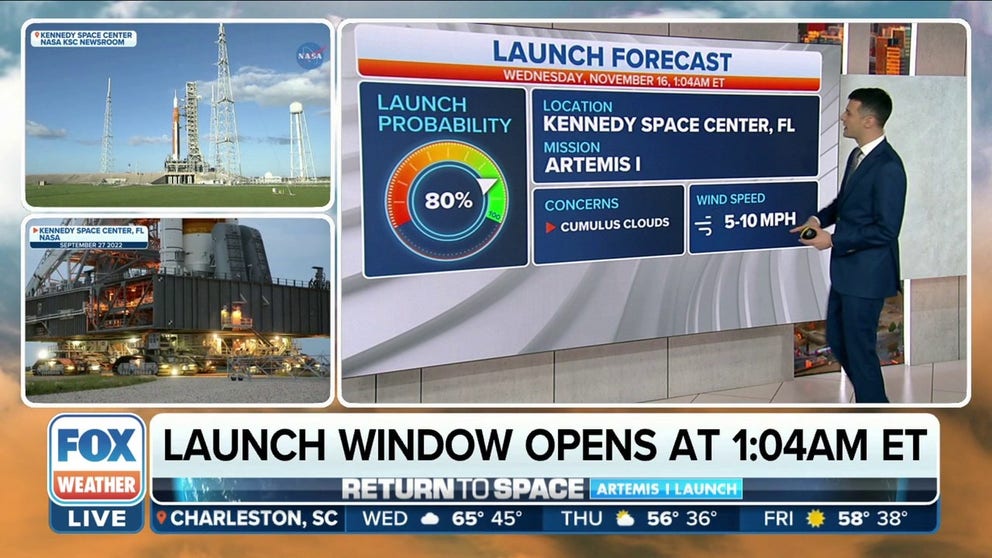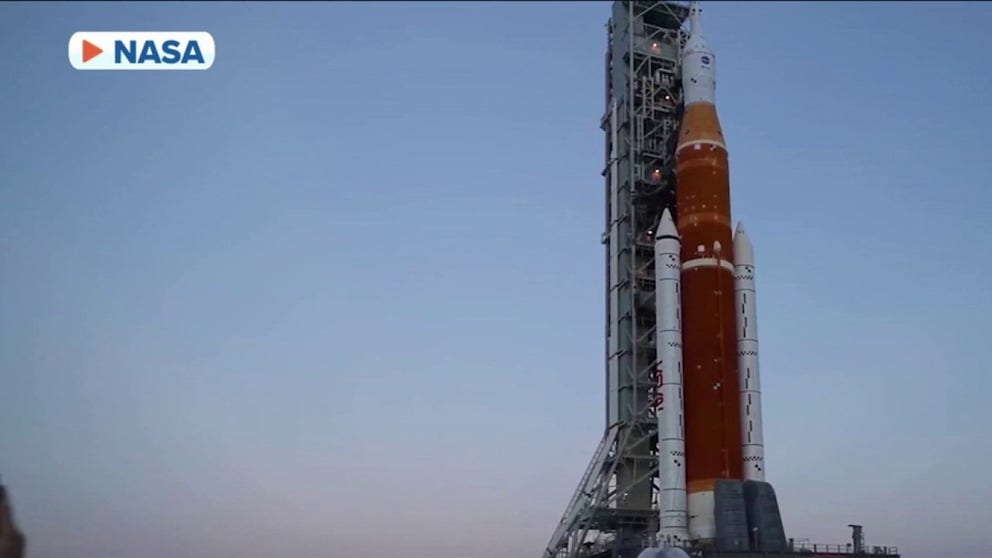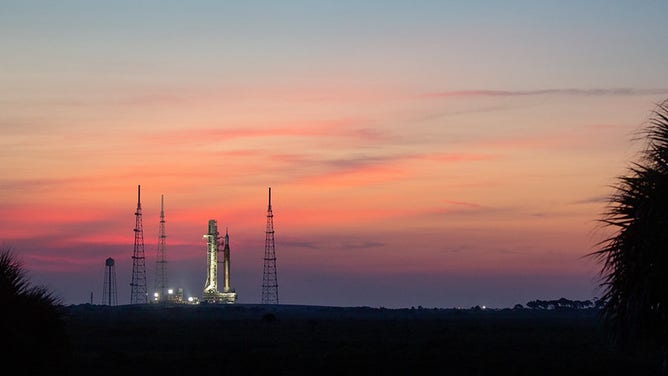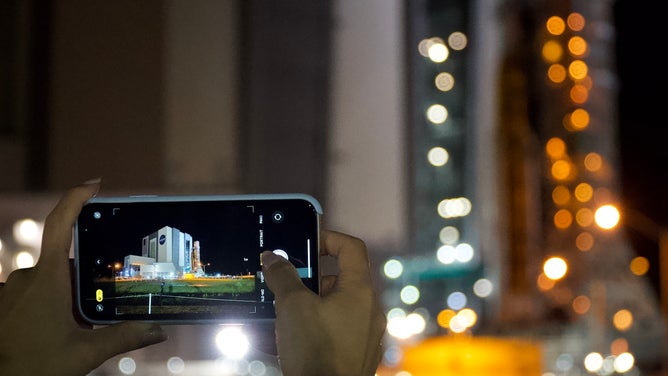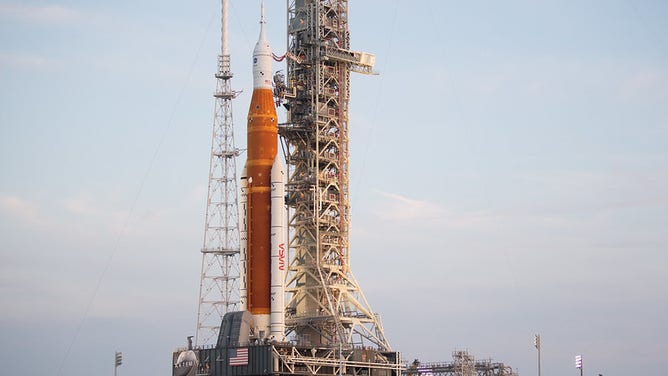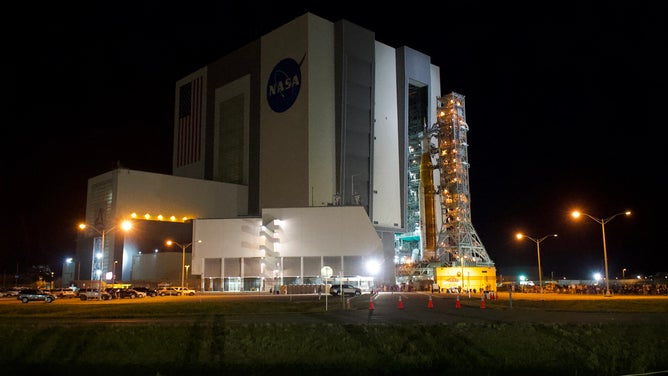NASA's Artemis moon rocket makes final journey on Earth to the launchpad
The SLS and Orion spacecraft take the final journey to the launchpad ahead of the NASA's Aug. 29 Artemis 1 launch to the moon from Kennedy Space Center.
Artemis 1 has 80% chance of favorable launch conditions
With a launch window opening at 1:04 AM ET, Artemis 1 has a 80% chance of favorable launch conditions.
KENNEDY SPACE CENTER, Fla. – NASA's 32-story moon rocket began its last slow trip to the launchpad Tuesday night before launching the Orion spacecraft to the moon later this month.
The Space Launch System rocket and Orion spacecraft exited the Vehicle Assembly Building (VAB) at Kennedy Space Center around 10 p.m. starting the journey on a vehicle known as the Crawler Transporter 2 to launchpad 39B, about 4 miles to the east. The trip took 10 hours as the crawler moves at a cruising speed of 2 mph.
HOW TO WATCH THE ARTEMIS 1 LAUNCH ONLINE AND ON FLORIDA'S SPACE COAST
Artemis 1 Launch Director Charlie Blackwell-Thompson gave the official "go" to begin the roll on Tuesday.
The High Bay 3 doors of the VAB opened Tuesday afternoon to reveal the mobile launcher and crawler inside getting ready for the move.
NASA moon rocket begins final journey on Earth
FOX Weather's Brandy Campbell is at Kennedy Space Center in Florida where NASA's SLS rocket and Orion spacecraft are rolling out to launchpad 39B ahead of liftoff to the moon later this month.
The first motion of the massive moon rocket was scheduled to start around 9 p.m. However, a storm cell brought lightning within 10 miles of the space center delaying the first motion. Florida is known for its summer thunderstorms, but this particular storm was the only one for about 200 miles, and it just happened to push over Kennedy Space Center when NASA intended to start the rollout.
After 10 p.m., NASA's worm logo and the full 322-foot-tall rocket and Orion spacecraft could be seen moving away from the VAB, which has been its home during the final months of launch preparations. Thousands of people came out to KSC, arriving hours early to see the rocket's last journey on Earth.
The crawler completed the SLS's journey to the launchpad Wednesday around 7:30 a.m. The same launch complex last hosted a liftoff to the moon in 1972 with the final Apollo mission.
Now that the Space Launch System and Orion have arrived, NASA said engineers and technicians would work to configure systems for launch.
SLS is slated to launch the uncrewed Orion spacecraft beginning the Artemis 1 mission on Aug. 29 at 8:33 a.m. The liftoff will mark the first time a rocket has launched a human-rated spacecraft to lunar orbit in 50 years.
There are many goals of this test flight, including testing Orion’s communication, navigation and guidance systems, ensuring the overall launch and performance of SLS and ensuring Orion’s heat shield can withstand Earth re-entry at 25,000 mph.
Artemis 1 Rollout forecast
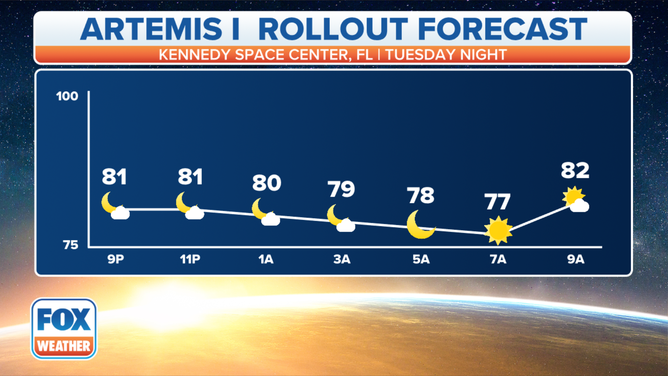
Forecast for Kennedy Space Center during the Artemis 1 rollout to launchpad 39B from Tuesday night into Wednesday morning.
(FOX Weather)
Before the giant moon rocket leaves the VAB, teams at NASA checked the forecast to ensure it was safe to move the more than 400-foot mobile launch tower and rocket across the 4-mile stretch to the pad.
WHAT IS NASA'S ARTEMIS 1 MISSION GOING TO DO?
The SLS will not begin rollout if the forecast shows lightning chances are greater than 10% within 20 nautical miles of the launchpad. The lightning rule is the criteria that delayed the rollout at the start.
A greater than 5% chance of hail could also delay the rollout, and peak winds must be below 40 knots.
The outside temperature is also a factor. The rollout could delay if the temperature is less than 40 degrees Fahrenheit -- which won't be a problem for August in Florida – or if it's above 95 degrees.
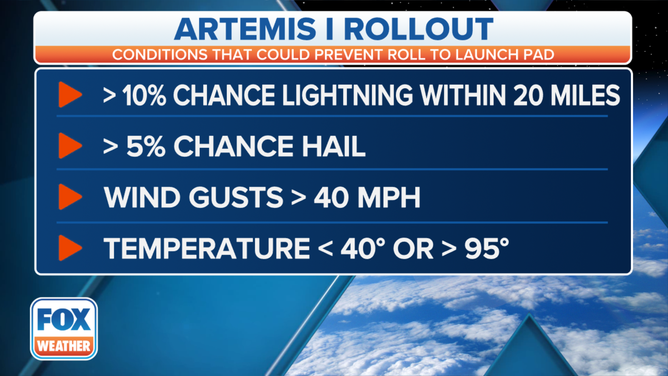
Some weather conditions that could prevent NASA from moving the SLS and Orion to the launchpad.
(FOX Weather)
Around 100,000 people are expected to travel to Florida's Space Coast to see the historic launch. If you're one of the thousands traveling to witness the launch, here is a list of possible viewing spots.
If the launch is delayed, the space agency also has Sept. 2 and Sept. 5 as backup launch dates.
While Artemis 1 will not have any humans aboard, there is one manikin and two manikin torsos loaded up the Orion spacecraft. The manikins will capture vital data for the future human crew.
The Artemis 2 mission is expected to launch a crew of four astronauts from NASA's Kennedy Space Center to lunar orbit. Later four astronauts will launch on the Artemis 3 mission making a historic return to the moon's surface by 2025.
